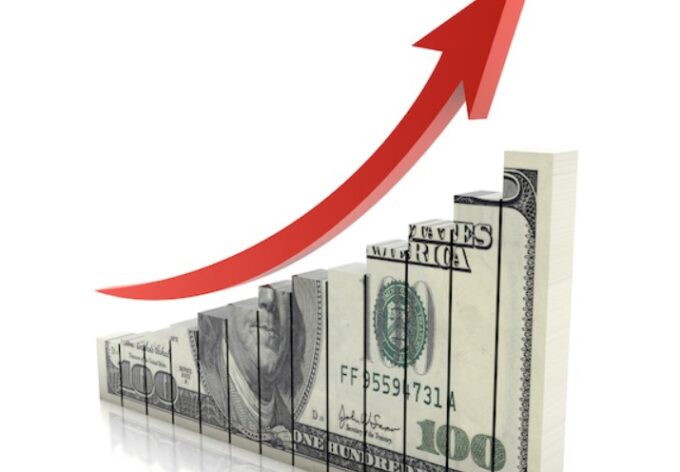This report provides the last five years’ revenues and revenue growth of Amazon.Com, Inc. (AMZN) from 2012 to 2016. Amazon generated a total of $136 billion in revenues during 2016. Amazon reported revenue growth of 27.1% year-over-year during 2016. The revenues and the revenue growth correspond to the fiscal year ending in December. Here are the revenues and the revenue growth details of Amazon during the last five years:
- Amazon generated a total of $61.1 billion in revenues during 2012. Amazon reported revenue growth of 27.1% year-over-year during 2012.
- Amazon generated a total of $74.5 billion in revenues during 2013. Amazon reported revenue growth of 21.9% year-over-year during 2013.
- Amazon generated a total of $89 billion in revenues during 2014. Amazon reported revenue growth of 19.5% year-over-year during 2014.
- Amazon generated a total of $107 billion in revenues during 2015. Amazon reported revenue growth of 20.2% year-over-year during 2015.
- Amazon generated a total of $136 billion in revenues during 2016. Amazon reported revenue growth of 27.1% year-over-year during 2016.
WHY ANALYZE REVENUE GROWTH?

Revenue growth is the most commonly analyzed financial metric. Revenue Growth is the percent increase (or decrease) of a company’s revenue between two time periods. It is computed by using the following formula: ((revenues during the time period two – revenues during the time period one) / revenues during the time period one)*100. If the time periods are two consecutive years, then the revenue growth is referred to as the annual revenue growth year-over-year.
If the time periods are two consecutive quarters, then the revenue growth is referred to as the quarterly revenue growth quarter-over-quarter. If the time periods refer to the same quarter in the two consecutive years, then the revenue growth is referred to as quarterly revenue growth year-over-year. In case the time periods are two non-consecutive years, then the revenue CAGR (Commutative Annual Growth Rate) is computed.
Revenue growth analysis is important for a number of reasons. First, it helps in understanding how a business is performing. If the revenue growth rates are positive, it means the business is performing well and the revenues are increasing. If the revenue growth rates are negative, it means the revenues are declining and the company needs to take measures to increase them. If they don’t, the company will continue to shrink.
Second, a company’s historical revenue growth analysis along with the market size and market share analysis helps in forecasting the future revenues of a company. Third, a comparison of a company’s growth rates with its competitors helps in determining who is winning more business. A revenue growth higher than the industry average translates into increased market share. Companies with very high revenue growth rates have the potential to be industry disrupters.
AMAZON RANKING

With $136 billion revenues, Amazon ranked number 12 in the R&P; Research list of top-3000 public companies in the US by revenues during 2016. Each one of the top-3000 companies generated more than $50 million of annual revenues during 2016.
The top-20 companies in the US by revenues during 2016 were:
- Walmart ($482.1 billion)
- ExxonMobil ($226.1 billion)
- Berkshire Hathaway ($223.6 billion)
- Apple ($215.6 billion)
- McKesson ($190.9 billion)
- UnitedHealth Group ($184.8 billion)
- CVS Health ($177.5 billion)
- General Motors ($166.4 billion)
- AT&T; ($163.8 billion)
- Ford Motor ($151.8 billion)
- AmerisourceBergen ($146.8 billion)
- Amazon ($136 billion)
- Verizon ($126 billion)
- General Electric ($123.7 billion)
- Cardinal Health ($121.5 billion)
- Costco ($118.7 billion)
- Walgreens Boots Alliance ($117.4 billion)
- Chevron ($114.5 billion)
- Kroger ($109.8 billion)
- Express Scripts Holding ($100.3 billion)
For the purpose of performance benchmarking of a company with a sector or industry average, R&P; Research associates every company with one sector and one industry. An industry consists of companies with related/similar business models. A sector comprises of a group of related/similar industries. For example, Life Sciences sector is comprised of following industries: Pharmaceuticals; Medical Devices; Biotechnology; Diagnostics & Scientific Instruments.
Amazon is associated with Technology Sector and Internet Industry.
With $136 billion revenues, Amazon ranked number 2 of all the companies in the US Technology sector. There were a total of 406 public companies in the US Technology sector that had revenues greater than $50 million during 2016.
The top-10 companies in the US Technology sector by revenues during 2016 were:
- Apple ($215.6 billion)
- Amazon ($136 billion)
- Alphabet ($90.3 billion)
- Microsoft ($85.3 billion)
- IBM ($79.9 billion)
- Intel ($59.4 billion)
- Hewlett Packard Enterprise ($50.1 billion)
- Cisco Systems ($49.2 billion)
- HP ($48.2 billion)
- Oracle ($37 billion)
Technology sector is comprised of the following industries: Computers Systems and Peripherals; Software; Semiconductor; IT Consulting and Outsourcing Services; Networking Equipment and Services; Internet; Other. The definitions for each of the industries is as follows:
- Computers Systems and Peripherals industry includes companies primarily engaged in manufacturing of personal computers, servers, mainframes, workstations, and other computer accessories and peripherals such as storage drives, mice, keyboards and printers. It also includes manufacturers of mobile phones and tablets.
- Software industry includes businesses providing software products such as operating systems, productivity suites, enterprise software, data and analysis software, advertising and marketing software, engineering and manufacturing software, networking software, and IT management software. It also includes companies providing industry-specific software focused on different sectors such as Financials, Automotive, Telecom, Utilities, Travel, Real Estate, Media, and Publishing.
- Semiconductor industry includes companies primarily engaged in manufacturing and distribution of semiconductor products such as microprocessors, chipsets, motherboards, flash memory, and wired and wireless connectivity products. It also includes companies that provide semiconductor equipment and services to the semiconductor industry.
- IT Consulting and Outsourcing Services industry includes companies primarily engaged in providing information technology consulting and outsourcing services to other businesses. The services include IT consulting, systems integration, application development and management, IT infrastructure management, and network operations management.
- Networking Equipment and Services industry includes companies primarily engaged in manufacturing and distribution of networking and communications equipment for transporting data, voice, and video traffic across intranets, extranets, and the Internet. The key products include routers and switches for local and wide-area networks, cable modems, teleconferencing equipment, and wireless access points.
- Internet industry includes Internet-based businesses providing products and services such as search engines, social networking, web hosting, email, domain name registration, and eCommerce. It also includes industry information/services portals focused on different sectors such as Financials, Automotive, Travel, Health, Real Estate, Media, and Publishing.
- Other industry includes companies providing products such as photocopiers, fax machines, point of sale machines, audio/video technologies, and video games. It also includes technology companies that are not part of other six technology industries.

With $136 billion revenues, Amazon ranked number 1 of all the companies in the US Internet industry. There were a total of 74 public companies in the US Internet industry that had revenues greater than $50 million during 2016.
The top-10 companies in the US Internet industry by revenues during 2016 were:
COMPANIES SEGMENTATION
To identify and analyze high/low growth or most/least profitable similar-size companies in different sectors or industries, R&P; research classifies all companies into different segments based upon their revenues, revenue growth, and net profit margins.
Based upon their annual revenues, the companies are classified into one of the following four segments:
- Mega companies, having revenues greater than $50 billion.
- Very Large companies, having revenues between $10 billion and $50 billion.
- Large companies, having revenues between $1 billion and $10 billion.
- Mid-size companies, having revenues between $50 million and $1 billion.
With $136 billion revenues, Amazon was in the Mega companies revenue segment during 2016. There were a total of 54 companies in the Mega companies revenue segment during 2016.
Based upon their annual revenue growth, the companies are classified into one of the following eight segments:
- Very High positive growth companies, having annual revenue growth greater than 50%.
- High positive growth companies, having annual revenue growth between 20% and 50%.
- Medium positive growth companies, having annual revenue growth between 5% and 20%.
- Low positive growth companies, having annual revenue growth between 0% and 5%.
- Low negative growth companies, having annual revenue growth between -5% and 0%.
- Medium negative growth companies, having annual revenue growth between -20% and -5%.
- High negative growth companies, having annual revenue growth between -50% and -20%.
- Very High negative growth companies, having annual revenue growth less than -50%.
With 27.1% revenue growth year-over-year, Amazon was in the High positive revenue growth segment during 2016. There were a total of 376 companies in the High positive revenue growth segment during 2016. Of the US top-3000 companies, 1985 (nearly two-third of the total) had positive revenue growth and 1015 (nearly one-third of the total) had negative revenue growth during 2016.
Based upon their annual net profit margin, the companies are classified into one of the following eight segments:
- Very High positive margin companies, having net profit margin greater than 50%.
- High positive margin companies, having net profit margin between 20% and 50%.
- Medium positive margin companies, having net profit margin between 5% and 20%.
- Low positive margin companies, having net profit margin between 0% and 5%.
- Low negative margin companies, having net profit margin between -5% and 0%.
- Medium negative margin companies, having net profit margin between -20% and -5%.
- High negative margin companies, having net profit margin between -50% and -20%.
- Very High negative margin companies, having net profit margin less than -50%.

With a net margin of 1.7%, Amazon was in the Low positive net profit margin segment during 2016. There were a total of 707 companies in the Low positive net profit margin segment during 2016. Of the US top-3000 companies, 2244 (nearly three-fourth of the total) had positive net profit margin and 756 (nearly one-fourth of the total) had negative net profit margin during 2016.
COMPANY BUSINESS SUMMARY
Amazon.com, Inc. engages in the retail sale of consumer products and subscriptions in North America and internationally. It operates through the North America, International, and Amazon Web Services (AWS) segments. The company sells merchandise and content purchased for resale from vendors, as well as those offered by third-party sellers through retail Websites, such as amazon.com, amazon.ca, amazon.com.mx, amazon.com.au, amazon.com.br, amazon.cn, amazon.fr, amazon.de, amazon.in, amazon.it, amazon.co.jp, amazon.nl, amazon.es, and amazon.co.uk. It also manufactures and sells electronic devices, including kindle e-readers, fire tablets, fire TVs, and echo; and provides Kindle Direct Publishing, an online service that allows independent authors and publishers to make their books available in the Kindle Store. In addition, the company offers programs that enable sellers to sell their products on its Websites, as well as their own branded Websites; and programs that allow authors, musicians, filmmakers, app developers, and others to publish and sell content. Further, it provides compute, storage, database, and other AWS services, as well as fulfillment, publishing, digital content subscriptions, advertising, and co-branded credit card agreements services. Additionally, the company offers Amazon Prime, an annual membership program, which provides free shipping of various items; access to unlimited streaming of movies and TV episodes; and other services. It serves consumers, sellers, developers, enterprises, and content creators. The company was founded in 1994 and is headquartered in Seattle, Washington.

DATA SOURCE
The chart and the data on this page are sourced from the R&P; Research Industry Intelligence Platform. The platform provides the key financial metrics for all the public companies in the United States. The platform empowers users to compare last five or 15 years financial data of a company with the other companies or the industry averages. This benchmarking exercise yields powerful insights that can drive better business decisions.
















